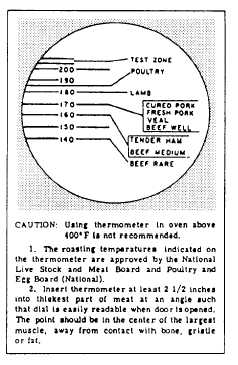| |
The following rules pertaining to roasting apply to
beef, veal, pork, and lamb. Included with each rule is
the “why.”
l Use a moderately low oven temperature (325°F)
so the roast will be uniformly done throughout, the
cooking losses will be moderate, the meat will be more
palatable, and the roast will be plump and full. High
temperatures cause excessive shrinkage, uneven
cooking, and decreased juiciness and tenderness.
. Do not sear meat before roasting. Searing
toughens the outer layer of meat, increases cooking
losses, causes a loss of fat, and contributes to excessive
shrinkage.
. Place roast fat side up on the pan. This eliminates
basting; as the meat cooks, it will baste itself with the
melting fat.
. Add salt to the roast before or after it is cooked.
Salt penetrates less than half an inch below the surface
and any salt added before the roast is cooked adds flavor
to the drippings.
. Unless specified in the AFRS recipe, never cover
a roast. If the roasting pan is covered, the moisture
escaping from the meat will surround it and the meat
will be cooked by moist heat.
. Do not add water. Roasts cooked without water
are juicier and more flavorful. The only reason for
adding water would be to keep the drippings from
becoming too brown. This will not happen, however,
when low oven temperatures are used.
. Do not flour the roast. Drippings from a floured
roast may be a more attractive brown, but the same
results can be obtained by browning flour in the
drippings when you make the gravy.
. Use a meat thermometer to tell when the roast is
done. The meat thermometer is the only accurate
measure of doneness. The length of cooking time
depends on the temperature of the oven, the weight and
shape of the roast, and the kind of meat. A dial-type meat
thermometer is shown in figure 6-5.
The thermometer should be inserted into the center
of the main muscle (the thickest part of the meat) so that
the tip of the thermometer does not touch the bone,
gristle, or the fat. As the heat from the oven penetrates
the meat, the internal temperature at the center of the
roast gradually rises and this rise is registered on the
thermometer. When the thermometer registers the
Figure 6-5.—Dial-type roast meat thermometer.
desired temperature for that particular kind of meat, the
roast is ready to be removed from the oven.
. Boneless meat will require a somewhat longer
cooking period than meat with bones. A smaller roast
requires more minutes per pound than a larger one.
Follow the AFRS recipe that specifies the type of meat
required and the proper cooking temperature.
Cooking time is only a guide to meat doneness.
Roasts will continue to cook slightly after being
removed from the oven. Cooking time depends
principally upon the size and cut of the meat, the degree
of doneness desired or required, and the cooking
temperature. The temperatures at which meats are
cooked also determine cooking times. Maintaining
even temperatures aids in predicting cooking periods.
For information on convection oven cooking, check the
AFRS guidelines, specific recipes, and manufacturer’s
directions for meat cookery.
POULTRY
Poultry is a menu favorite. Chicken, duck, Rock
Cornish hen, and turkey are the main poultry items used
in Navy messes.
6-10
|

